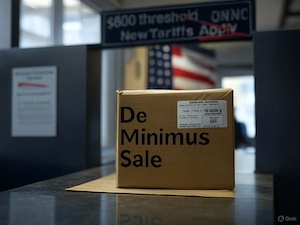On April 2, 2025, U.S. President Donald Trump signed an executive order altering the “de minimis”* regulation, ending the $800 duty-free threshold for shipments from China and Hong Kong effective May 2, 2025, with plans to extend this globally. The White House cited deceptive shipping practices, particularly from Chinese shippers sending illicit substances like fentanyl, as the rationale. U.S. Customs data shows over 21,000 pounds of fentanyl seized at borders, highlighting security concerns. Previously, 1.4 billion de minimis packages entered the U.S. in 2023, up from 153 million in 2015, after the threshold rose from $200 to $800.
The change to the de minimis regulation will affect the purchasing of cheap products in the U.S. Starting May 2, 2025, shipments from China and Hong Kong valued under $800 will no longer enter duty-free, facing tariffs of 30% of their value or $25 per item (rising to $50 after June 1, 2025), with plans to extend this globally. A mailing option allows packages under $150 sent via postal services to remain exempt, but they require electronic customs data.
Most cheap products—often imported from China by e-commerce platforms, drop shippers, or small businesses—previously relied on the $800 threshold to avoid duties and keep prices low.
Costs
With added tariffs and customs processing, the cost of these goods will increase. For example, a $10 item from China could see a $3 duty (30%), raising its landed cost to $13, plus potential shipping and handling fees. Businesses like Shein, Temu, or small drop shippers may pass these costs to consumers, reducing the availability of ultra-low-priced items. (Even 50% on many of these products would still be mighty cheap.) Some may shift sourcing to countries with lower tariffs or domestic suppliers, but this could still raise prices due to higher production costs.
The mailing exemption might preserve some affordability for items under $150, though customs delays or compliance costs could offset savings. Overall, consumers will likely see fewer dirt-cheap imported options, with price increases varying by product and seller response.
A mailing option persists: packages under $150 sent via postal services remain exempt from duties but require electronic customs data. Trade will shift as imports face duties, potentially slowing e-commerce growth tied to low-cost imports. U.S. businesses may benefit from a leveled field but could see higher input costs, impacting prices. Foreign businesses, especially in China, face increased export costs, prompting supply chain shifts to places like Vietnam or Brazil. Drop shippers, reliant on de minimis for slim margins, will encounter higher costs and reporting burdens, possibly forcing operational changes.
Examples of affected businesses include small U.S.-based drop shippers like Jool Baby, which manufactures baby products in China for U.S. warehouses. Owner Avi Bergman plans to renegotiate with factories to offset tariffs, but costs may rise. Crunchgrowth, a revenue acceleration agency, cites a client selling electric razors from China; without de minimis, they may shift to U.S. manufacturing, increasing expenses. Large firms like Shein and Temu, Chinese e-commerce giants, ship directly to U.S. consumers. Shein is diversifying to Vietnam and Brazil, while Temu expands U.S. warehousing. Amazon’s Haul, a discount store, uses de minimis for imports but is a small part of its business. Shopify, supporting many small stores, sees 25% of its largest clients using de minimis, facing potential revenue drops as margins shrink. Shopify may also lose merchants unable to adapt to higher costs, though it could gain from those shifting to domestic suppliers.
USPS
The U.S. Postal Service (USPS), handling 40% of de minimis shipments, must process customs data for packages under $150, straining resources and risking delays. Packages over $150 face duties, reducing USPS’s edge over private carriers like FedEx, who handle 60% and must bond for duties. With 3-4 million daily packages, volume may shift or overwhelm USPS. Commerce Secretary Howard Lutnick will assess these effects within 90 days, guiding future adjustments.
“De minimis” is a Latin term meaning “of minimal things” or “concerning trifles.” In the context of U.S. trade and customs regulations, it refers to a threshold below which imported goods are exempt from duties and taxes, and often from detailed customs documentation. Historically, this was designed to reduce administrative burdens for low-value shipments, allowing them to enter the country with minimal processing. Before the recent change, the de minimis threshold in the U.S. was $800, meaning packages valued under that amount could be imported duty-free. The term is widely used in legal and economic contexts to denote matters too small to warrant significant attention or regulation.
White House Fact Sheet: https://www.whitehouse.gov/fact-sheets/2025/04/fact-sheet-president-donald-j-trump-closes-de-minimis-exemptions-to-combat-chinas-role-in-americas-synthetic-opioid-crisis/
